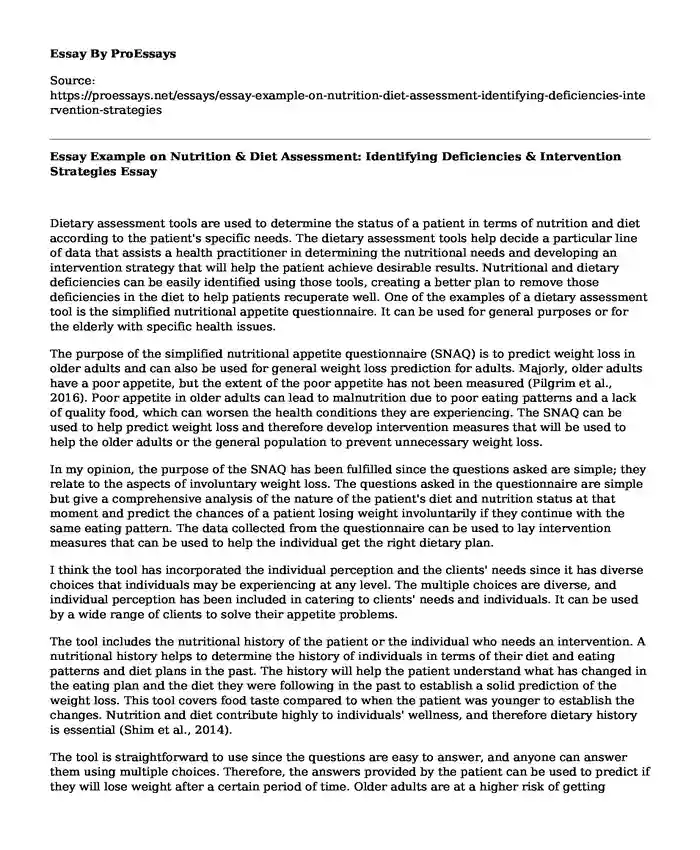Dietary assessment tools are used to determine the status of a patient in terms of nutrition and diet according to the patient's specific needs. The dietary assessment tools help decide a particular line of data that assists a health practitioner in determining the nutritional needs and developing an intervention strategy that will help the patient achieve desirable results. Nutritional and dietary deficiencies can be easily identified using those tools, creating a better plan to remove those deficiencies in the diet to help patients recuperate well. One of the examples of a dietary assessment tool is the simplified nutritional appetite questionnaire. It can be used for general purposes or for the elderly with specific health issues.
The purpose of the simplified nutritional appetite questionnaire (SNAQ) is to predict weight loss in older adults and can also be used for general weight loss prediction for adults. Majorly, older adults have a poor appetite, but the extent of the poor appetite has not been measured (Pilgrim et al., 2016). Poor appetite in older adults can lead to malnutrition due to poor eating patterns and a lack of quality food, which can worsen the health conditions they are experiencing. The SNAQ can be used to help predict weight loss and therefore develop intervention measures that will be used to help the older adults or the general population to prevent unnecessary weight loss.
In my opinion, the purpose of the SNAQ has been fulfilled since the questions asked are simple; they relate to the aspects of involuntary weight loss. The questions asked in the questionnaire are simple but give a comprehensive analysis of the nature of the patient's diet and nutrition status at that moment and predict the chances of a patient losing weight involuntarily if they continue with the same eating pattern. The data collected from the questionnaire can be used to lay intervention measures that can be used to help the individual get the right dietary plan.
I think the tool has incorporated the individual perception and the clients' needs since it has diverse choices that individuals may be experiencing at any level. The multiple choices are diverse, and individual perception has been included in catering to clients' needs and individuals. It can be used by a wide range of clients to solve their appetite problems.
The tool includes the nutritional history of the patient or the individual who needs an intervention. A nutritional history helps to determine the history of individuals in terms of their diet and eating patterns and diet plans in the past. The history will help the patient understand what has changed in the eating plan and the diet they were following in the past to establish a solid prediction of the weight loss. This tool covers food taste compared to when the patient was younger to establish the changes. Nutrition and diet contribute highly to individuals' wellness, and therefore dietary history is essential (Shim et al., 2014).
The tool is straightforward to use since the questions are easy to answer, and anyone can answer them using multiple choices. Therefore, the answers provided by the patient can be used to predict if they will lose weight after a certain period of time. Older adults are at a higher risk of getting malnutrition and weight loss due to loss of appetite; therefore, this tool can be used easily to help them (Wang & Shen, 2018).
I think the tool has enough information needed to establish intervention measures that can be used to prevent involuntary weight loss that can lead to malnutrition among older adults and the general adult population. The general score will determine the next steps to be taken.
References
Pilgrim, A. L., Baylis, D., Jameson, K. A., Cooper, C., Sayer, A. A., Robinson, S. M., & Roberts, H. C. (2016). Measuring Appetite with the Simplified Nutritional Appetite Questionnaire Identifies Hospitalised Older People at Risk of Worse Health Outcomes. The Journal of Nutrition, Health & Aging, 20(1), 3–7. https://doi.org/10.1007/s12603-015-0533-9
Shim, J. S., Oh, K., & Kim, H. C. (2014). Dietary assessment methods in epidemiologic studies. Epidemiology and Health, 36, e2014009. https://doi.org/10.4178/epih/e2014009
Wang, T., & Shen, J. (2018). Usefulness of simplified nutritional appetite questionnaire (SNAQ) in appetite assessment in elder patients with liver cirrhosis. The Journal of Nutrition, Health & Aging, 22(8), 911-915.https://doi.org/10.1007/s12603-018-1086-5
Cite this page
Essay Example on Nutrition & Diet Assessment: Identifying Deficiencies & Intervention Strategies. (2023, Oct 27). Retrieved from https://proessays.net/essays/essay-example-on-nutrition-diet-assessment-identifying-deficiencies-intervention-strategies
If you are the original author of this essay and no longer wish to have it published on the ProEssays website, please click below to request its removal:
- Autonomy, Liberty Rights, and the Principle of Noninterference in Drugs and Alcohol
- Essay Sample on Role of Epidemiology in Public Health
- Essay Sample on Obesity Among Adults and Children in the United Kingdom
- Essay Example on the Department of Health and Human Services
- Essay on Hematologist-Family Nurse Practitioner Collaboration: A Must-Have Skill
- Covid-19: New Biz Ideas for Pandemic Solutions - Research Paper
- Free Report Example on Ethical Dilemmas in Healthcare: Challenges and Solutions







